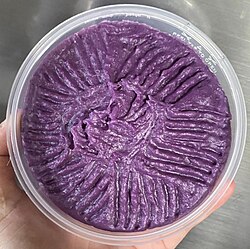 A container of kōʻele pālau made with Okinawan sweet potato, a local variety A container of kōʻele pālau made with Okinawan sweet potato, a local variety | |
| Alternative names | Kōʻele pālau, pālau |
|---|---|
| Type | Pudding |
| Course | Dessert |
| Place of origin | Hawaii |
| Serving temperature | Warm or cold |
| Main ingredients | Sweet potatoes, coconut milk |
| Ingredients generally used | Salt, sugar, shredded coconut |
| Variations | Poi |
| Similar dishes | Piele, pepeieʻe, kūlolo, poi (dessert), nilupak, ube halaya |
Kōʻelepālau (anglicized as koelepalau), or pālau, is a Hawaiian pudding made primarily with cooked sweet potatoes mixed with coconut cream. It is similar to other Native Hawaiian puddings like kūlolo and piele.
It was once a dish well documented by many non-Hawaiians as an everyday dish, or as a dessert found at ʻahaʻaina (or lūʻau) found alongside kūlolo, and was noted by Robert Louis Stevenson during his visits in the late 1800s.
History
Sweet potato is one of the most earliest, cultivated crop carried into the central Pacific Islands by Austronesian peoples around 1300 AD, where they became a staple crop of Polynesians. Although associated as a root vegetable, all parts of the sweet potato was utilized. However, sweet potatoes were considered inferior and less valuable than taro, or kōʻele―a rare term used for "less desirable portions of meat or fish," but it was able to flourish in unfavorable growing conditions.
Preparation
Traditional kōʻelepālau recipes call for sweet potatoes roasted over coals or kālua (cooked in an imu or earth oven). In modern recipes, any method to cook sweet potatoes can be used such as steaming or boiling. The sweet potatoes are usually removed of its skin then thoroughly mashed. Coconut milk, or milk substitute, is then mixed to the desired consistency. Optionally, additional sugar can be added or garnished with shredded coconut.
See also
- Haupia – Polynesian coconut milk pudding
- Kūlolo – Hawaiian dessert using coconut milk
- Sweet potato haupia pie – Hawaiian dessert
- Poi (food) – Traditional staple food in the Polynesian diet
- Poi (dessert) – Traditional Samoan fruit dessert
References
- Pālau is the abbreviated name for kōʻelepālau as well as the ancient Maui dialect term for sweet potato. The common Native Hawaiian term for sweet potato is ʻuala (or ʻuwala).
- ^ "Pālau". Nā Puke Wehewehe ʻŌlelo Hawaiʻi. Ulukau. Retrieved 13 October 2023.
- "'Uala, 'uwala". Nā Puke Wehewehe ʻŌlelo Hawaiʻi. Ulukau. Retrieved 13 October 2023.
- "kōʻelepālau". Wehewiki Hawaiian Language Dictionaries. University of Hawaii at Hilo - Ka Haka ʻUla O Keʻelikōlani College of Hawaiian Language. Retrieved 13 October 2023.
- "Recipes". Kaʻiwakīloumoku - Hawaiian Cultural Center. Kamehameha Schools. Retrieved 13 October 2023.
- "Piele". Wehewiki Hawaiian Language Dictionaries. University of Hawaii at Hilo - Ka Haka ʻUla O Keʻelikōlani College of Hawaiian Language. Retrieved 13 October 2023.
- Brickwood (1896). Hawaiian Cook Book (4th ed.). Honolulu, Hawaii: Hawaiian Gazette Company. p. 132. Retrieved 13 October 2023.
- Kaufman, Jessie (1912). A Jewel of the Seas. Philadelphia, US: J.B. Lippincott Company. p. 130. Retrieved 13 October 2023.
- Warriner, E. V. (July 1916). Scudder, Doremus (ed.). The Ninety-Fourth Annual Conference of the Hawaiian Evangelical Association. Honolulu, Hawaii: Volume LXXIV. The Friend. p. 150. Retrieved 13 October 2023.
- M.D.; Goodhue, E. S. (1917). Ford, Alexander Hume; Mellen, George (eds.). The Man in the Malo (1 ed.). Honolulu, Territory of Hawaii: Volume XIII. Mid-Pacific Magazine. p. 391.
- Johnstone, Arthur (1905). Recollections of Robert Louis Stevenson in the Pacific. London, UK: Chatto & Windus. p. 304. ISBN 978-0-8414-5324-1.
- O'Connor, Kaori (June 2008). "The Hawaiian Luau: Food as Tradition , Transgression , Transformation and Travel". Food, Culture & Society. 11 (2): 149–172. doi:10.2752/175174408X317543. ISSN 1552-8014. Retrieved 13 October 2023.
- Denham, Tim (October 2011). "Early Agriculture and Plant Domestication in New Guinea and Island Southeast Asia". Current Anthropology. 52 (S4): S379 – S395. doi:10.1086/658682. hdl:1885/75070. S2CID 36818517.
- Winnicki, Elizabeth; Kagawa-Viviani, Aurora; Perez, Kauahi; Radovich, Theodore; Kantar, Michael (2021). "Characterizing the Diversity of Hawai'i Sweet Potatoes (Ipomoea batatas Lam.)". Economic Botany. 75: 48–62. doi:10.1007/s12231-020-09511-2. S2CID 234165494.
- Yen, Douglas E. (1961). Sweet-potato variation and its relation to human migration in the Pacific. Pacific Science Association.
- "Kō.ʻele". Nā Puke Wehewehe ʻŌlelo Hawaiʻi. Ulukau. Retrieved 13 October 2023.
- Hommon, Robert J. (2013). The ancient Hawaiian state: origins of a political society. Oxford University Press. ISBN 9780199916122.
- "Kōʻelepālau". Kokua Hawaii Foundation. May 30, 2018. Retrieved 13 October 2023.
- Naluai, Camille. "Kō'elepālau". Kaʻiwakīloumoku - Hawaiian Cultural Center. Kamehameha Schools. Retrieved 13 October 2023.
- Kealoha Hoe, Herbert (2000). "Koele Palau (Sweet Potato Dessert)". The Electric Kitchen. Hawaiian Electric Company, Inc. Retrieved 13 October 2023.
- "Koele Palau (Sweet Potato Pudding)". The Electric Kitchen. Hawaiian Electric Company, Inc. Retrieved 13 October 2023.